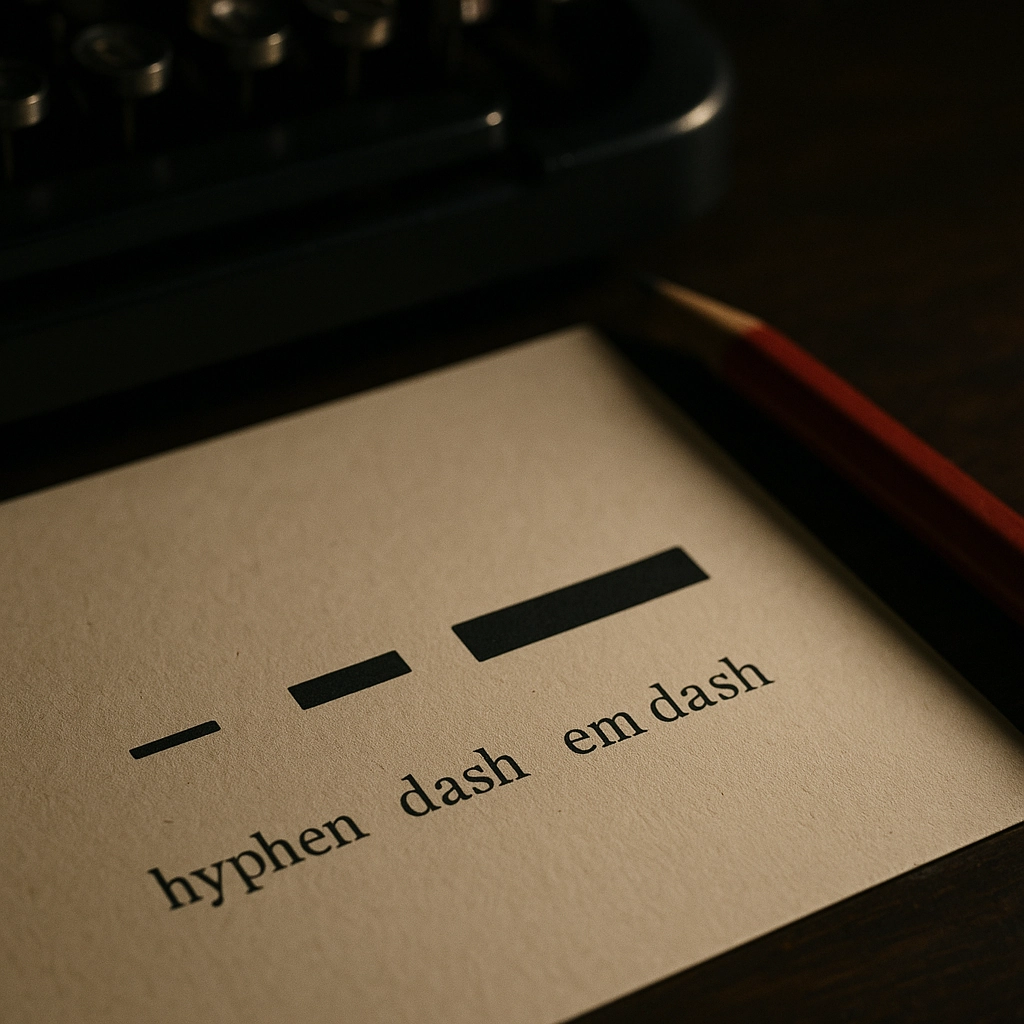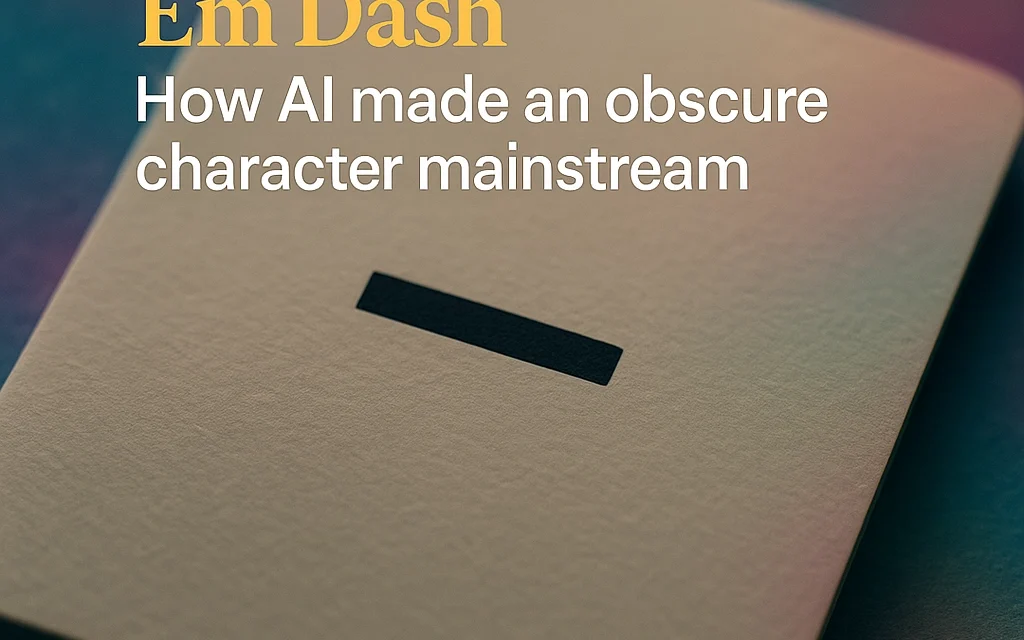The Curious Case of a Character That’s Suddenly Everywhere
Have you noticed a strange horizontal line appearing in text messages, emails, and social media posts lately?
No, not the humble hyphen (-) that connects compound words, but its sophisticated cousin, the em dash (—). This previously obscure punctuation mark has mysteriously infiltrated our digital communications, and there’s a fascinating explanation for its sudden rise to fame: large language models (commonly called AI)
As someone who spends considerable time reviewing and creating content online, I’ve watched with growing amusement as this once-specialized character has become ubiquitous. The irony isn’t lost on me that I’m using AI assistance to write about AI’s punctuation habits. Let’s explore how a character that doesn’t even appear on standard keyboards became the unofficial signature of the AI revolution.
What Exactly Is This Mysterious Mark?
The em dash is a horizontal line roughly the length of the letter “m” (hence the name). It’s longer than both the hyphen (-) and the en dash (–), making it visually distinctive in text.

Traditionally, writers and editors used em dashes to indicate a break in thought, to emphasize a point, or to insert an aside that feels more dramatic than parentheses but less formal than colons. It creates a visual interruption that mirrors natural speech patterns when we suddenly change direction or add emphasis. My personal preference is two dashes “–“.
The problem? Unlike most punctuation, there’s no dedicated key for it on standard keyboards. Creating an em dash typically requires a special key combination (Alt+0151 on Windows) or using character substitution features. This technical barrier historically limited its use to professional writers, editors, and typography enthusiasts.
From Literary Device to Digital Fingerprint
The em dash isn’t new. Writers like Emily Dickinson famously adored this punctuation mark, using it extensively to create her signature breathless, urgent poetic style. Journalists and book publishers have employed it for generations to structure complex sentences and add dramatic flair to prose.
What’s changed is how frequently we encounter it in everyday text. Before AI chatbots became mainstream tools, seeing an em dash in a casual message might raise an eyebrow. Now, they appear constantly in AI-generated content from chatbots, email assistants, and content creation tools.
But why? The answer lies in how large language models learn language patterns.
Why AI Loves This Punctuation So Much
AI writing tools weren’t programmed with a specific preference for em dashes. Instead, they learned language patterns by analyzing billions of text examples from books, articles, websites, and other written sources. Many of these sources follow professional publishing standards where em dashes are used properly and frequently.

Unlike human writers constrained by keyboard limitations, AI has no trouble inserting typographically correct em dashes. When drafting text, AI models simply choose the punctuation that best fits the context based on their training data. And frequently, that choice is the versatile em dash.
Three key factors explain the proliferation:
- Training data influence: AI models were trained on high-quality published writing where em dashes appear regularly.
- No keyboard constraints: AI doesn’t need to remember keyboard shortcuts or worry about how to type special characters.
- Versatility in context: The em dash serves multiple grammatical functions, making it useful in various situations where AI needs to connect ideas.
The Social Impact: From Obscurity to Suspicion
As AI tools have become everyday companions for millions of users, their punctuation preferences have subtly reshaped our digital landscape. The once-rare em dash now appears in everything from marketing emails to social media posts to business communications.
This shift hasn’t gone unnoticed. In fact, the prevalence of em dashes has become something of a tell-tale sign of AI-generated content. Some LinkedIn influencers and educators have even started pointing to frequent em dash usage as a way to spot AI-written text.
“Looking for a way to tell if something was written by AI? Count the em dashes,” wrote one viral post that circulated widely in 2023.
The irony is palpable. A punctuation mark cherished by literary giants like Dickinson is now viewed with suspicion simply because AI has made it more accessible. Human writers who naturally gravitate toward em dashes suddenly find their authentic style flagged as potentially machine-generated.
The Great Punctuation Debate
Like the Oxford comma or double spacing after periods, the em dash has become a polarizing subject. Some writing experts consider it elegant and versatile, while others view it as a crutch for writers who can’t structure sentences properly.

What’s fascinating is how AI has amplified this debate. Before widespread AI adoption, discussions about em dashes were largely confined to editorial meetings and style guide committees. Now, they’re part of broader conversations about technology’s influence on language and authenticity in communication.
Some publications have even updated their style guides specifically to address the AI association. A few have gone so far as to restrict em dash usage to avoid the perception of AI-generated content, creating a bizarre situation where human writers are changing their natural style to seem more human.
The Self-Referential Twist
Writing about em dashes without using them creates an interesting challenge. It’s like describing the color red while showing only blue. The constraints force creativity and alternative punctuation choices, highlighting how much we might rely on certain marks without realizing it.
This meta-awareness extends to the broader relationship between AI and language. AI doesn’t create new linguistic patterns from nothing; it amplifies existing human tendencies. The em dash was always there in our literary tradition. AI simply democratized it, bringing it out of specialized publishing contexts and into everyday messages.
What This Tells Us About Language Evolution
The story of the em dash’s rise isn’t just about punctuation. It’s about how technology subtly shapes communication norms and how quickly those changes can spread through digital channels.
Throughout history, communication technologies have influenced language. The telegram made messages terser. The smartphone gave us emoji. Now, AI is normalizing once-specialized punctuation and phrasing patterns, creating new linguistic markers in the process.
For writers, educators, and communicators, this raises interesting questions:
- How do we distinguish between AI-influenced style and authentic personal expression?
- Should we embrace these changes or resist them?
- What other subtle linguistic shifts are happening beneath our notice?
The Future of AI-Influenced Writing
As AI writing tools become more sophisticated and widespread, we’ll likely see more examples of this phenomenon. Obscure grammatical constructions, specialized vocabulary, and other linguistic features from AI’s training data will increasingly appear in everyday communications.
Rather than fighting this evolution, perhaps we should view it as an opportunity to expand our communicative toolkit. After all, language has always been shaped by the technologies we use to transmit it.
The humble em dash, once relegated to style guides and literature classrooms, now serves as a fascinating case study in how technology democratizes specialized knowledge. Whether you view its proliferation as linguistic enrichment or AI contamination likely depends on your perspective about technology’s role in communication more broadly.
Conclusion: Punctuation as Identity
In the end, the story of the em dash reminds us that even the smallest elements of written language carry cultural significance. What appears to be a simple horizontal line turns out to be a marker of identity, expertise, and now, technological influence.
The next time you receive a message filled with these distinctive marks, you might pause to consider their journey: from the manuscripts of 19th-century poets to the algorithms of 21st-century AI, and finally, to your screen. It’s a small but telling example of how our relationship with technology continues to reshape even the most fundamental aspects of how we communicate.
And yes, I wrote this entire article about em dashes without using a single one. The irony of that constraint while using AI to discuss AI’s impact on punctuation provides the perfect punctuation to this exploration.

